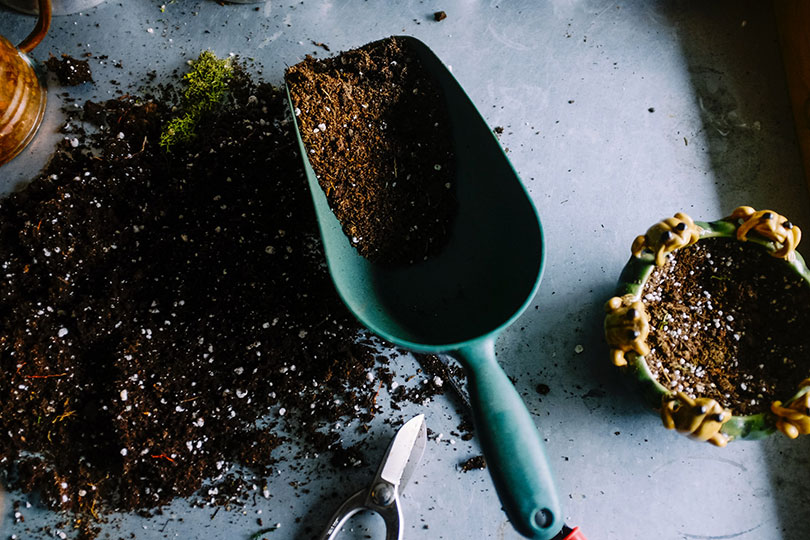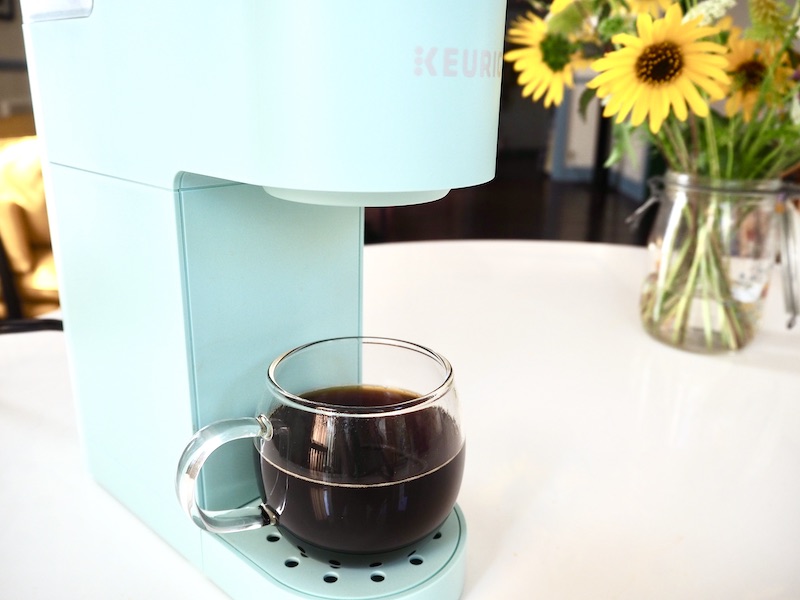
Millions of people wake up every morning craving a cup of coffee. Most coffee lovers simply toss the used coffee grounds into the trash, not even thinking twice about them. If you are a coffee drinker, you can build up a large surplus of coffee grounds quite easily. Did you know you can put your used coffee grounds in your garden or yard?
Avid gardeners know the benefits of composting. The saying, “if you feed the soil, the soil will feed the plants, and the plants will feed you,” explains the importance of the organic material. One of the perfect ways to “feed your soil” is with compost.
A healthy compost mixture requires a balance of carbon-rich brown compost (dried leaves or grasses, dead plant clippings, wood branches, hay, and pine needles) and wet, nitrogen-rich compost (fresh grass clippings, food scraps, tea bags, or fresh leaves).
Used coffee grounds are an outstanding source of organic matter or food scraps. Not only can you compost with your coffee grounds to enrich the pile, but you can also add the grounds directly to your soil to enrich it and deter unwanted pests. Coffee grounds have a naturally high nitrogen content, meaning they are considered organic material and, therefore, green compost.

What is Compost?
At its core, compost is essentially decomposed or decomposing organic matter. Think of organic matter like living materials such as leaves, grass, vegetable or fruit scraps (like the rind on a watermelon or an orange peel), and even your coffee grounds!
Compositing is a fantastic way to turn your kitchen scraps into a fertilizer for your garden. The average family produces over 200 pounds of kitchen waste in food scraps per year that can be used as compost rather than thrown into landfills.
For your compost to be effective, you have to have a healthy and balanced mix between green and brown compost. The balance between the green and brown compost is extremely important— without balance, your compost will not heat up and decompose effectively. Important microbes live in your compost pile.
Carbon from brown compost provides these microbes with energy, and nitrogen from green compost provides them with protein.
Brown compost is made up of materials that are high in carbon or are carbohydrate-rich. It is primarily a food source for the microorganisms living in your soil that break down the contents of the compost pile. Brown compost materials also add bulk and body to your compost pile so that air can circulate throughout it.
Green compost, on the other hand, is comprised of materials rich in protein or nitrogen. These items are exactly what they sound like—fresh, wet, or recently grown materials. These fresh items, like weeds, eggshells, and grass clippings, help the microorganisms within the compost pile grow and quickly multiply.

How Do You Use Coffee in Compost?
Adding your coffee grounds to the compost pile doesn’t take lots of work. However, we recommend working smarter rather than harder. The first rule of using coffee grounds in your compost is knowing that they are considered green compost. Because coffee grounds are rich in nitrogen, you need to mix your active coffee grounds with carbon-rich, or brown compost materials like dried leaves or shredded paper.
Creating Your Compost Mix
Coffee grounds contain nitrogen and other essential nutrients like calcium, magnesium, and potassium. All of these minerals provide important nutrients that benefit growing plants. In addition to providing protein for the compost pile, the nitrogen also allows plants to perform photosynthesis— or convert sunlight into energy.
When using your coffee grounds in a compost mixture, be careful not to overindulge in mixing them. A 4-to-1 ratio of brown compost to green is the ideal combination. This ratio ensures there is enough nitrogen in your mixture to decompose properly. You can mix in coffee grounds with your used coffee filters if you wish!
Having too much nitrogen, or green material, in your compost pile can release ammonium gas and other foul odors. In other words, if you add too much green material to your compost pile, it can actually start to smell. However, if you don’t have enough, the pile won’t heat up and decompose.
Composting Coffee Grounds
Remember when we said you could mix your coffee grounds with the coffee filters? You don’t need any extra supplies or fancy tricks to compost your grounds. These little beauties will compost on their own as long as you have a hefty supply of coffee grounds and brown compost like shredded paper (hint: the coffee filters).
Make sure to shred or tear the coffee filters into strips to help the composting process. Even though organic coffee filters will decompose better, the regular white filters will also work.. While the basic white filters might be slower to break down, they can be added to your compost as long as they are biodegradable.
You can compost used or fresh coffee grounds. However, unless you have a fresh stash of coffee grounds somewhere in your house you don’t actually intend to use, you’ll most likely be using used coffee grounds for your composting purposes. There are better ways to use fresh coffee grounds. But don’t fear, you can add that package of stale grounds you forgot in the back of your fridge without problems.

Can You Compost K-Cups?
Even though K-Cups are surrounded by plastic, the used grounds and paper linings within can actually be composted. You simply have to separate the grounds and paper from the plastic shell. You can purchase special cutters specifically made to separate the K-Cup from the paper liner and coffee grounds within, but you can also do it with a sharp knife or your trusty pair of kitchen scissors.
Separating a K-Cup from the Contents
Get your favorite knife, special cutters, or kitchen scissors ready.
- Cut the foil top of the K-Cup away from the plastic cup.
- Run your knife or scissors around the inside rim of the plastic up to cut the filter away from the plastic.
- Place the coffee grounds and filter in a bowl or container.
- Toss the filters and coffee grounds in your compost pile.
If you look closely, you’ll see that some companies now produce organic K-Cups that are fully compostable. The cups are made from organic materials and can be placed into the compost bin without having to be opened or separated.

Coffee Grounds Are Green Compost
Composting with coffee grounds is an excellent way to reduce your family’s carbon footprint. You can reduce your food waste while improving your garden and the condition of your soil.
Whether you compost only on a small scale with the grounds from your morning pot of coffee, or you seek out large amounts to make a full-blown compost pile, coffee grounds are an invaluable asset to your gardens. Save your grounds if you want to enrich your soil!
See Also: Are Coffee Grounds Good for Grass? What You Need to Know!
- https://pela.earth/blogs/news/composting-with-coffee-grounds#:~:text=But%2C%20you%20should%20be%20aware,dried%20leaves%20or%20shredded%20paper.
- https://www.thespruce.com/using-coffee-grounds-in-your-garden-2539864
- https://driftaway.coffee/composting/
- https://www.gardeners.com/how-to/coffee-grounds-in-compost-bin/8611.html
- https://www.gardenmyths.com/how-to-compost-browns-greens/
Featured Image Credit: DGLimages, Shutterstock













